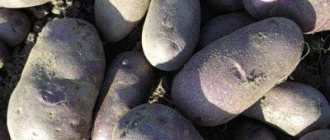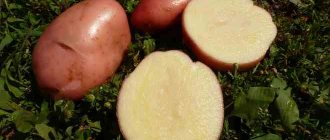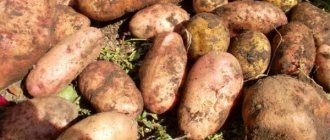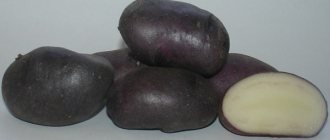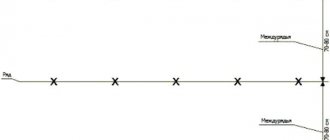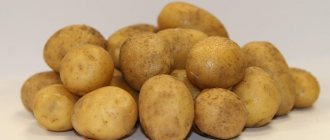Description of Christel's potatoes
Christel potatoes are a table variety, a universal variety with excellent taste, resistant to most of the most dangerous diseases of this crop. The bushes of this potato are quite voluminous and require a lot of sun and free space. Main characteristics of the Christel plant:
- The bush is of medium height, semi-erect, spreading, well-leafed.
- The leaves of the variety are large, intermediate, almost open, bright green.
- The tubers are oval-shaped, weighing 120-130 g, the peel is light yellow, the eyes are frequent and small.
- The potato flesh is dark yellow, slightly oily, boils poorly, and almost does not darken when cooked.
The starch content in the Christel tuber is up to 14%. The average yield is 350 c/ha, the maximum is 600 c/ha.
Description and characteristics of the variety
Sofia potatoes belong to the early ripening table category; ripening time to full technical ripeness is 60-80 days.
The tubers have excellent taste (score 4.7 points) and attractive appearance. The pulp may darken slightly after heat treatment.
What do tubers look like:
- average weight 92-115 g;
- aligned elongated shape;
- the skin is deep yellow;
- the pulp is oily, yellowish;
- peel with mesh, rough;
- eyes 2-3 mm each.
Starch content is below average (10.5-13.3%). The tubers do not cook well and are not suitable for puree. They are eaten boiled (jacket potatoes), baked, fried. Potatoes are used in a variety of first courses.
What regions is it suitable for?
Sofia potatoes are actively cultivated in a temperate continental climate. This is the territory of such districts as Volgo-Vyatsky and Central. It can also be grown in the northern regions within the North-West region.
Advantages and disadvantages
Kristel boasts many important characteristics for a potato grower. The most important advantages of this variety:
- yield - in fertile soils you can collect more than 600 c/ha;
- high marketability - the content of full-bodied, high-quality tubers in the potato harvest reaches 96%;
- good keeping quality - at least 94% of potatoes of this variety can last until spring;
- excellent immunity - potatoes are not subject to infection by golden nematode, cancer and banded mosaic.
However, it is worth mentioning a few noticeable flaws that the variety may exhibit. The most significant disadvantages of the vegetable:
- vulnerability to late blight on tubers (unlike varieties such as Lina) and powdery porsche - it is better to treat the seeds of the variety with a fungicide before planting;
- elite potatoes, not very common in Russia - they are difficult to get and the seed material is not cheap.
In addition, Christel will have to be protected from parasites and, above all, from the Colorado potato beetle.
Landing
The potatoes in question prefer crumbly, nutritious soils. Sandy loam or chernozem soil with neutral acidity is best suited for Christel.
Soil preparation
In September, the potato plot is dug up with a shovel, removing all the roots and insect larvae. Then the earth is pickled, according to the characteristics, with Trichopolum, or copper sulfate, and fertilized with a solution of mullein, or urea. 4-5 days before planting, the soil under Kristel is loosened again, thoroughly weeded, and humus or wood ash is added.
Landing Features
10-14 days before planting, Christel is sorted and germinated in a warm, dry room, in open boxes. Potatoes are planted, judging by the characteristics, in mid-April, in the South - at the beginning of the month. To add potatoes, choose a fine, but not too hot, windless day. The optimal distance between neighboring bushes of the variety is 45-50 cm. The recommended width of the space between the rows that Christel will require is 65-70 cm.
Landing Features
The seed material of the variety is planted depending on weather conditions. It is better not to carry out planting work after heavy rains or before frosts. Petrovich potatoes are introduced into the soil on a clear, sunny day, in dry soil, so that the tubers do not begin to rot.
Landing dates
In loamy, non-chernozem soils, the Petrovich variety, according to its characteristics, is planted in the first half of May. In the fertile Black Earth Region, potatoes can be planted already in the first days of this month. The soil temperature by this moment should be no lower than 10°, and the air should warm up to 12-14°.
Dry, windless weather is best for planting.
Soil preparation
The earliest, autumn preparation of soil for potatoes consists of cleanly clearing the area of all remnants of the previous harvest. This is followed by digging to a depth of 15-20 cm and the application of organic fertilizers. In the spring, a week before planting potatoes, the ground is loosened again, weeded, removing all traces of weeds, and then manured (for Petrovich, you can use chicken droppings).
Planting scheme
Potatoes are ready for planting after 3-4 weeks of germination in a warm place. By this time, sprouts of 0.8-1.3 cm should appear on the tubers. They are carefully transferred into pre-cut holes to a depth of 5-6 cm. The distance between neighboring bushes for this variety, according to the characteristics, is 40 cm, the row spacing is varies from 60 to 65 cm. Before adding Petrovich tubers, fertilizer is placed in the holes - ash, compost, saltpeter, or peat.
Care
Christel is spudded 2 times per season. The first time the potatoes are sprinkled with earth when they grow 15 cm, the second time when the potatoes reach a height of 23-24 cm. The earth is poured so that 6 cm of the bush remain uncovered.
The variety is loosened and watered at the same frequency, on the same day - 1-2 times a week, depending on the weather, since Christel is afraid of prolonged droughts. For successful potato growth, the soil needs to remain well-moistened to a depth of 10 cm.
Timely weeding is no less important - otherwise Christel may become infected with various viruses from the weeds. Uncleanly weeded potatoes often attract parasites, so plantings need to be treated at least once a week.
Top dressing
This variety does not require large doses of fertilizers, but at the same time it responds well to potassium-phosphorus and organic mixtures. It is recommended to feed Kristel according to the following regimen:
- The first time - a week after planting - chicken manure is applied to the potatoes.
- After 10-14 days, the potatoes are fertilized with nitroammophos.
- After another 10 days of planting, they are fed with potassium sulfate.
- The last fertilizer for Kristel - before the first digging - is superphosphate and humus.
It is best to fertilize such potatoes using the root method.
Description of the Arosa potato variety, cultivation characteristics and yield
The Arosa potato variety, bred by breeders from Germany less than 10 years ago, is grown not only in Europe; it is also popular on other continents. Tubers are used for preparing various dishes, side dishes, and producing chips. Boiled young potatoes, which begin to be dug up a month and a half after germination, are adored by both adults and children. Arosa easily tolerates heat and drought, which allows you to grow potatoes without installing an irrigation system.
Description of the variety
From each bush of a plant that has a beautiful shape, smooth straight stems, and abundant foliage, 15 or more tubers weighing 120 grams are dug out. The yield of Arosa per hectare exceeds 55 tons. Potatoes are different:
- yellow pulp;
- pink skin;
- rough surface covered with eyes.
One root vegetable contains slightly less than 15% starch and contains folic acid, phosphorus, magnesium and calcium. Young potatoes are rich in vitamin C, which restores tissue cells, strengthens bones and teeth, and protects the body from infection.
The description of the variety and its external characteristics attracted farmers and gardeners from different regions of Russia.
Arosa is cultivated both in Western Siberia and in the southern regions, collecting excellent harvests. The potatoes sprout evenly, the branches grow straight, the dense inflorescences have a reddish color.
Root crops fully ripen in 70 days, but they are dug up for cooking, baking, frying, and preparing salads after 45–50.
Gardeners love Arosa potatoes:
- for ease of care;
- resistance to viruses;
- great taste.
Farmers value the variety because the tubers are not damaged during transportation and retain their marketable appearance for a long time. Such a characteristic as keeping quality, which is 94%, is also of great importance for them. The Arosa variety adapts to any soil and tolerates both cold and hot weather.
Growing
Tubers are planted in the ground when it warms up well. Sowing begins in the southern regions, in Siberia and in the middle zone - a week or 2 later. So that the variety does not let down the yield, choose a root crop:
- weighing from 55 to 75 grams;
- with eyes on the surface;
- no dents or scratches.
Shoots will appear earlier if the potatoes left for seeds are sprouted in advance. The best place for a garden bed will be the area where:
- spring and beans;
- mustard and cabbage;
- rapeseed and radish.
The soil is fed with manure, dug up without loosening the lumps; insects that live in the ground will freeze in winter.
When the soil warms up, tubers are planted. To do this, a place for a hole is marked every 30 cm, leaving 70 between the rows. Sprouted potatoes are placed in the holes and covered with soil.
Features of care
To grow a good harvest, it is not enough just to follow the rules of agricultural technology. The ripening period of tubers is affected not only by the weather, but also by how the rules for caring for Arosa potatoes are followed; the description of the variety indicates the need:
- hilling beds;
- feeding with fertilizers;
- weed removal;
- soil moisture.
Despite its resistance to drought and heat, in order to grow large root crops, the beds need to be watered. It is better to do this early in the morning or late in the evening, otherwise there is a risk of sunburn on the foliage. It is necessary to moisten the soil when sprouts emerge to the surface, form buds, and after flowering. Stop watering potatoes during rains and three weeks before digging up the tubers.
The bushes are hilled several times per season, the first when their height reaches 18 or 20 cm. During feeding, the dosage of fertilizers should not be exceeded, as this will deteriorate the taste of the tubers.
At the beginning of the growing season, it is better to use the mineral substances superphosphate and nitroammophosphate. When buds form, potassium salt and ash are added to the root of the plant. The third feeding is optional. Nutrient components are well absorbed if they are added during watering.
Experienced gardeners spray the tops with a solution of Bordeaux mixture twice a season.
Advantages and disadvantages
Arosa potatoes have clear advantages over other varieties of this crop. Root crops are suitable for consumption within a month and a half after planting, have a pleasant taste and high shelf life. Arosa is not affected by many diseases, but requires mandatory treatment for scab and rhizoctonia. An important advantage of the variety is drought resistance.
Pests and diseases
Arosa plantations attract with beautiful bushes and lush foliage of a rich green hue, and dense purple inflorescences.
The variety is not affected by mosaic - striped or wrinkled. Arosa rarely suffers from leaf curl and late blight, dry spotting, and does not get sick:
- fusarium;
- verticillium wilt;
- potato cancer.
The variety is not resistant to rhizocnoniosis, which is caused by pathogenic fungi. The problem is easy to detect in the spring. Not all planted tubers germinate; the sprouts that appear curl. Arosa is susceptible to infection with silver scab. To prevent these diseases, seed material is treated with fungicides or potassium permanganate.
To prevent the development of late blight, gardeners cut off the tops two weeks before digging up root crops.
Mole crickets cause great damage to the crop. Insects, reaching a length of up to 5 cm, dig holes in the ground, destroy sprouts and seeds, and damage tubers. To protect potatoes from this insect, root crops are treated with Prestige or Aktara before planting. They cope with it using insecticides Boverin, Medvedox, Rembek.
Colorado beetles can destroy not only beds, but also entire fields of nightshade crops in a short time. They fight the parasite, which feasts on both tops and leaves, using folk methods and by treating potatoes with chemicals. Not all pest control drugs can destroy Colorado potato beetles, since after a while the toxic substances cease to pose a danger to the insects, and the parasites get used to them.
Systemic agents that contain several active components are most effective in the fight against arthropods. Bushido insecticide instantly paralyzes pests, affecting the nervous and digestive systems. When spraying potatoes with Bankol, Gulliver, Intavir, larvae and adults die.
Harvest and storage
Tubers of the Arosa variety for preparing salads, cooking and frying are dug up already a month and a half after germination. For long-term storage and chip production, the crop is harvested 20 days later.
Root crops are dried and then sent to the basement or cellar. Arosa potatoes have excellent keeping quality and do not lose their taste and presentation until May. Judging by the reviews, this is one of the best early ripening varieties.
dachamechty.ru
Diseases and parasites: prevention and control
Christel is moderately resistant to most diseases, but this potato still has a few weak points. To avoid infection and dominance of parasites, according to the characteristics, it is necessary to observe crop rotation, cleanly weed the beds of the variety, and plant strong-smelling plants around the site.
Late blight
The disease can affect potatoes at high humidity and high temperatures. Late blight can be recognized by brownish, sticky ulcers on tubers and tops. To prevent planting, Christel is treated with Bordeaux mixture before flowering. Treat the infected variety with Ridomil and Alufit. Severely damaged bushes must be removed, and the places where they grew should be sprinkled with wood ash.
Powdery Porsha
Kristel becomes infected with this disease due to too much and not warm enough watering. Scab appears on potatoes as light, rotten spots - the skin cracks and the flesh rots. The Maxim-M fungicide works best with this type of scab on potatoes. The treatment is carried out in 2 stages with an interval of 2 weeks. After harvesting the variety, the soil is additionally disinfected with a solution of potassium permanganate or tobacco powder.
Colorado beetle
In warm climates, the pest is capable of destroying more than half of the potato plantings. To successfully fight for Christel, you need to inspect the bushes every 4-5 days so as not to miss the appearance of reddish larvae. At the first signs of infection, planting varieties are sprayed with a decoction of celandine, or hot pepper. If the moment is missed, the bushes are treated with Aktara or Tanrek.
Smart furrows
Long-term observations have proven the significant benefits of proper placement of furrows in potato plantings. Experienced agronomists say that it is important to make furrows from north to south. This method will help to properly illuminate the bushes of the plant during the day, and therefore they will receive maximum benefit and warmth, which will have a beneficial effect on the harvest in the end.
Don't forget to water and feed the potatoes
Remember, we must not forget to water the potatoes regularly. This will certainly affect the future harvest. The earth should not be dry. Water the potatoes with warm water, preferably using the drip method. This should be done at least 2-3 times per season. The same applies to feeding. It should be done according to a special scheme (2-3 times per season).
Harvesting and storage
They begin to dig up Christel on the 55th day after germination. Potatoes are harvested, according to the specifications, in mid-August - after most of the tops of the variety have turned yellow and died. It is cut off at the root 6-7 days before harvesting.
After digging, the potatoes are laid out on a mat under the sun for 2 days - they should dry out and get stronger. Christel is then stored in a well-ventilated, cool and darkened basement. There the variety is sorted periodically - 2 times a month. Under such conditions, potatoes can last until the last days of March.
The secret method for breaking the stem
More than a hundred years ago, Richard Schroeder invented a unique method for increasing potato yields. His secret was to break the stem of the plant at a level of 10-15 cm from the ground 14-21 days after flowering. It is important to do this very carefully so that the break does not allow the bush to rise, but the bush does not break completely. Thanks to this break, all the nutrients that went into the tops suddenly slowed down before the break and returned to the tubers. But at the same time, the above-ground part of the plant does not wither and photosynthesis occurs in the same way as before. Only healthy plants can be broken.
Since ancient times, potatoes have been worth their weight in gold, because if you do everything right, you can reap an impressive harvest and earn a lot of money by selling it. Agribusiness is one of the most profitable in the world, and therefore breeders tirelessly present us with new varieties of vegetable crops every year. Experiment - it always adds excitement and a sense of novelty.
